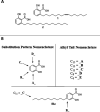Synthesis and Evaluation of Ginkgolic Acid Derivatives as SUMOylation Inhibitors
- PMID: 33214832
- PMCID: PMC7667826
- DOI: 10.1021/acsmedchemlett.0c00353
Synthesis and Evaluation of Ginkgolic Acid Derivatives as SUMOylation Inhibitors
Abstract
SUMOylation has emerged as an important post-translational modification that has been shown to modulate protein activity associated with various signaling pathways, and consequently, it has emerged as an important therapeutic target. While several natural products have been shown to inhibit enzymes involved in the SUMOylation process, there has been little progress toward the development of more selective and potent SUMOylation inhibitors. Ginkgolic acid was one of the first natural products discovered to inhibit the SUMO E1 enzyme. Despite its use to mechanistically investigate the SUMOylation process, ginkgolic acid also modulates other pathways as well. In this Letter, preliminary structure-activity relationships for ginkgolic acid as a SUMOylation inhibitor are presented.
Conflict of interest statement
The authors declare no competing financial interest.
Figures







Similar articles
-
Ginkgolic acid inhibits protein SUMOylation by blocking formation of the E1-SUMO intermediate.Chem Biol. 2009 Feb 27;16(2):133-40. doi: 10.1016/j.chembiol.2009.01.009. Chem Biol. 2009. PMID: 19246003
-
Topotecan and Ginkgolic Acid Inhibit the Expression and Transport Activity of Human Organic Anion Transporter 3 by Suppressing SUMOylation of the Transporter.Pharmaceutics. 2024 May 9;16(5):638. doi: 10.3390/pharmaceutics16050638. Pharmaceutics. 2024. PMID: 38794300 Free PMC article.
-
Spectomycin B1 as a novel SUMOylation inhibitor that directly binds to SUMO E2.ACS Chem Biol. 2013 Dec 20;8(12):2635-42. doi: 10.1021/cb400630z. Epub 2013 Oct 21. ACS Chem Biol. 2013. PMID: 24143955
-
Exploring potential targets for natural product therapy of DN: the role of SUMOylation.Front Pharmacol. 2024 Oct 4;15:1432724. doi: 10.3389/fphar.2024.1432724. eCollection 2024. Front Pharmacol. 2024. PMID: 39431155 Free PMC article. Review.
-
New insights into SUMOylation and NEDDylation in fibrosis.Front Pharmacol. 2024 Dec 4;15:1476699. doi: 10.3389/fphar.2024.1476699. eCollection 2024. Front Pharmacol. 2024. PMID: 39697538 Free PMC article. Review.
Cited by
-
Structure-Activity Relationship of Synthetic Ginkgolic Acid Analogs for Treating Type 2 Diabetes by PTPN9 Inhibition.Int J Mol Sci. 2022 Apr 1;23(7):3927. doi: 10.3390/ijms23073927. Int J Mol Sci. 2022. PMID: 35409287 Free PMC article.
-
Protective Effect of Curcuma Extract in an Ex Vivo Model of Retinal Degeneration via Antioxidant Activity and Targeting the SUMOylation.Oxid Med Cell Longev. 2022 Jul 29;2022:8923615. doi: 10.1155/2022/8923615. eCollection 2022. Oxid Med Cell Longev. 2022. PMID: 35941902 Free PMC article.
-
Phytoconstituent Profiles Associated with Relevant Antioxidant Potential and Variable Nutritive Effects of the Olive, Sweet Almond, and Black Mulberry Gemmotherapy Extracts.Antioxidants (Basel). 2023 Sep 4;12(9):1717. doi: 10.3390/antiox12091717. Antioxidants (Basel). 2023. PMID: 37760021 Free PMC article.
-
The SUMO Family: Mechanisms and Implications in Thyroid Cancer Pathogenesis and Therapy.Biomedicines. 2024 Oct 21;12(10):2408. doi: 10.3390/biomedicines12102408. Biomedicines. 2024. PMID: 39457720 Free PMC article. Review.
-
SUMOylation and NEDDylation in Primary and Metastatic Cancers to Bone.Front Cell Dev Biol. 2022 Apr 6;10:889002. doi: 10.3389/fcell.2022.889002. eCollection 2022. Front Cell Dev Biol. 2022. PMID: 35465332 Free PMC article. Review.
References
Grants and funding
LinkOut - more resources
Full Text Sources

